So another set of London elections has passed, the thorny issue of housing in London has been debated again with the reiteration for more to be done about it. While recently London has seen more council housing built compared to the rest of the country it hasn’t stopped private rents being higher than the national average, and house prices that are nearly double. There’s a long term target to build 50,000 houses in London but in truth the number oscillates between 20 to 25,000 and when it goes up that’s more down to macro-economic factors than specific housing policies in place.
Understandably there’s a lot of frustration and unhappiness surrounding the lack of housebuilding in London, but there’s also a good amount of creative thinking about how we might boost numbers too. Those with a keen interest in the discourse will already be familiar with Russell Curtis’ work on London’s golf courses and how they represent a golden opportunity for more housing, if they were ever repurposed. I’ll be touching on that and more as I broaden the debate out to other exclusive, under utilised patches of land that we could in theory unlock for development.
21st century London – pressure on space
It’s hard to believe now, but after World War II London’s population dipped and stayed below its pre-war level for decades with certain parts, especially the Docklands, left derelict and sparsely populated. Even in the 1980s there were squats in Central London that housed a number of artists and musicians that would go onto be household names – Culture Club, Thompson Twins, Bronski Beat, even Sting. Unused buildings ripe for re-appropriation in Zone 1 seems far fetched now, London is no longer a city with empty spaces, but it does house a surprising amount of under used space, which policy makers and built environment experts are increasingly vocal about.

Thanks to extensive work by Russell Curtis displayed as The Golf Belt, we know that Greater London is home to over 90 golf courses, of which many are owned by councils or other public bodies. The amount of land given over to golf equates to the London Borough of Brent, if it could all be repurposed, what a bonanza that would be for housing and other amenities.
To those who say that’s incredibly unreasonable and one can’t seize assets because we’re not Venezuela – London’s golf provision has to be seen in the context of the Home Counties. I live roughly 30 miles from the centre of London in NW Kent, within walking distance of me are nine-hole, 18-hole and 36-hole courses.
These are legit businesses that have a right to exist, my point is that if you eradicated all golf from London you don’t have to travel very far to play it outside, in fact there are 74 courses within five kilometres of London’s boundary (that doesn’t include my local courses, I’m probably around 11 kilometres from Sidcup). There must be well over 100 courses within 10 miles of Greater London’s boundary, part of the 1,800 courses that exist nationwide.
Public footpaths criss cross the golf courses in my locale, I’ve got a pretty good idea of who plays golf these days through taking walks along the fairway edge – 90% male, mostly white and mostly but not exclusively middle-aged. Many people who play golf are hypersensitive to notions that it’s elitist or unrepresentative, but you simply can’t escape it’s a huge amount of land reserved for a relatively small section of society that’s not particularly diverse, not unlike grouse moors.
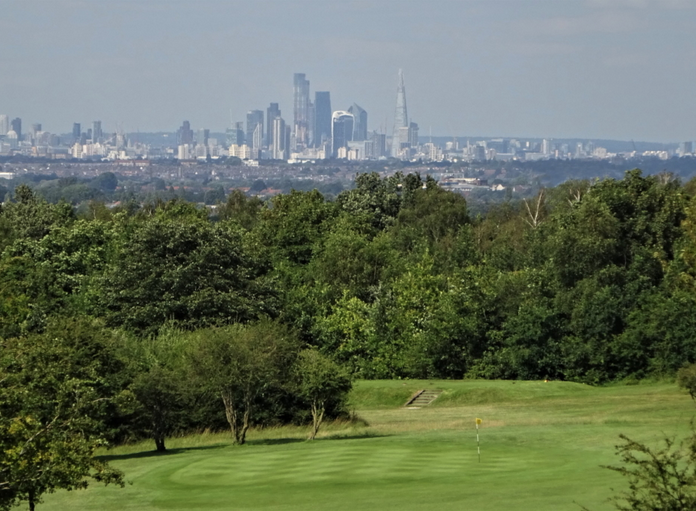
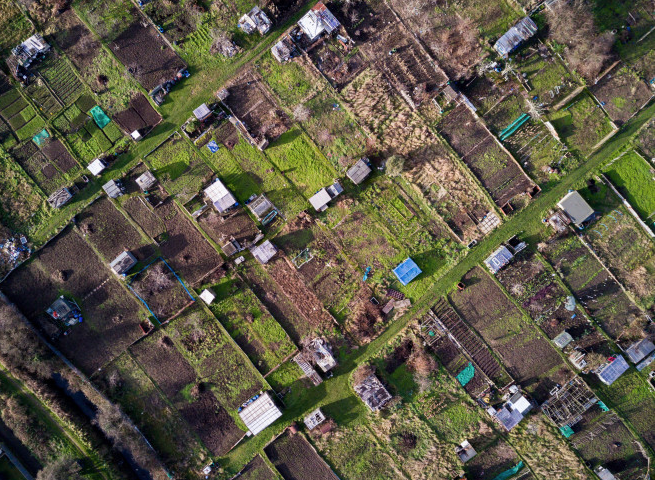

London’s golfers, should they be sent out into the Home Counties when there aren’t nearly enough allotments or children’s adventure playgrounds?
You’ve liberated a borough, what next?
As Curtis explains, there are very tight restrictions on metropolitan green space, possibly even more draconian than the Green Belt, so you’d need a revolution in planning to change the use of golf courses, but what if it were possible – you’d have a borough’s worth of land to play with. Everyone would have their own agenda of precisely how to use it. I, for one, would not build on all of it, I would allocate perhaps 50% to council housing (yes specifically just council housing, not housing association or ‘affordable’ private rent housing thank you).
The remaining 50% could be green space amenity – woodland, parkland and grassland with a focus on biodiversity – what’s bee-friendly, bird-friendly, worm-friendly and insect friendly. Let’s make rare shrubs, flowers and trees less rare with wild flower meadows, orchards and dew ponds. Add to that recreational facilities – London doesn’t have enough allotments, adventure playgrounds or team sports facilities – put football, cricket, rugby or hockey pitches in the right place they’ll be used intensively. To be as inclusive as possible, you’d also find space for outdoor gyms and multi-use games areas for court sports such as basketball and netball too.
For those that are hardcore environmentalists, building on half a borough’s worth of Greenfield land does not sound attractive – how can you make up for this? The simple answer is green roofs and green roadsides. There are tens of thousands of office blocks, low-to-mid rise apartment blocks and public sector buildings with flat or shallow roofs that could accommodate sedum roofs. Thousands of miles of roadside, especially in suburban London, could be significantly greener, with SuDS rain gardens, or lines of trees.
I know it sounds too good to be true, but it’s my contention you could build on half a borough of land – probably 100,000 houses – and suffer no great loss of green space if you managed London as a whole better. A great deal of will is required because all of these changes are controversial, even to those with no skin in the game.
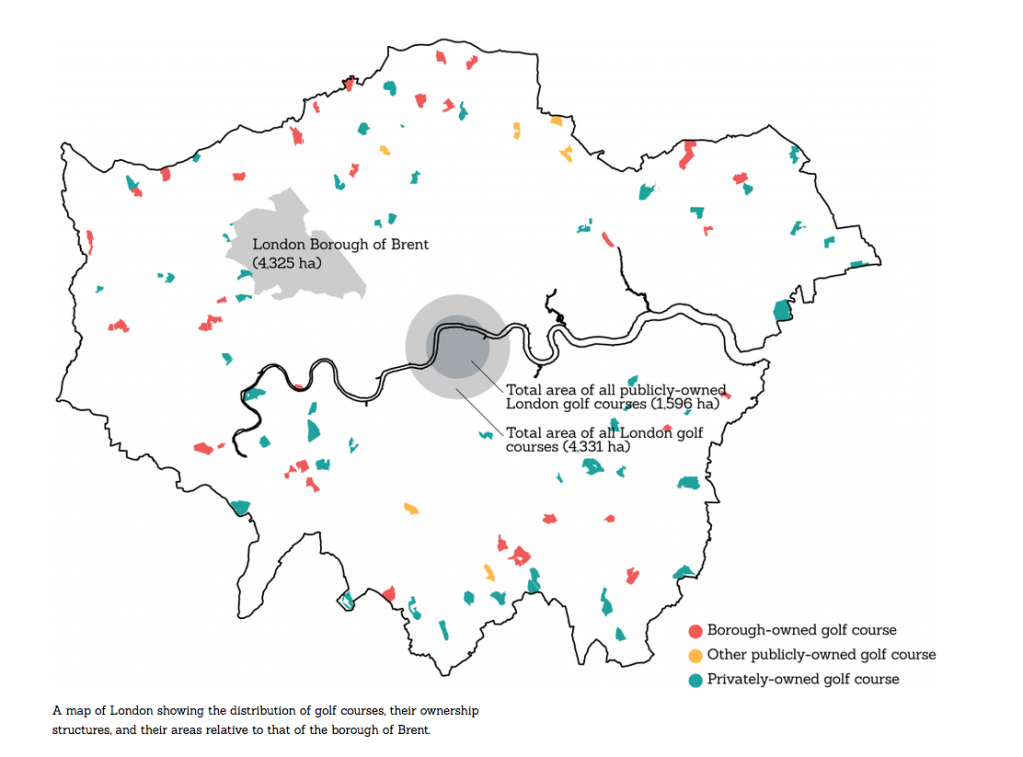
Other luxury spaces for the chopping board
It’s a measure of just how frustrated people are with the housing situation in London that the well-known revolutionary pamphlet The Financial Times sent one of their senior journalists out into London’s exurbs, and he earmarked a few places ripe for development. Chris Giles is a senior commentator for the FT, he walked round the outside of London, he now wants elite and therefore underused green space to be built on, as you can see from his tweet he’d start with Harrow School’s polo pitch – and he will forever be known as a class warrior.
This message didn’t spark much of a reaction from Old Harrovians – there aren’t that many of them and they don’t actually like to interact with anyone outside of their own social circle so people who’ve never been to Harrow and aren’t rich enough to send their children to Harrow objected in their place. It’s great to know that people in London who are ripped off with sky high house prices and exorbitant rents won’t sign off on anything radical to alleviate the situation and they just want everyone to suffer as much as they do.
Irrespective of the specific merits of seizing land from one of England’s most famous public schools, the fact that the debate has moved on from just golf courses to pretty much all exclusive and underused patches of green space is an indication of how strongly people now feel about the housing situation in London and the Home Counties and really incremental change isn’t going to solve it.
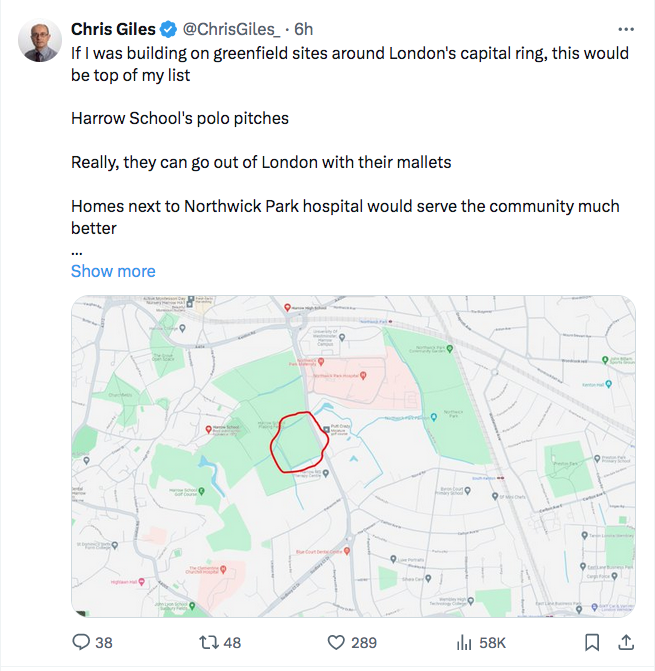
My own proposal – flatten London City Airport
In the last few years there’s been a pretty heated debate about the merits of the Silvertown tunnel, which will be completed next year. If you look at the scheme closely, one of its flaws is that it’s only marginally down river of the Blackwall Tunnel, it doesn’t make any sense if you’re looking to improve connectivity out East. Then you look at a map of the area, you couldn’t create another river crossing for another mile because London City Airport and bodies of water like the Royal Albert Dock are in the way on the Northern bank of the river. What if you were to do away with London City Airport and fill in the water courses surrounding it?
At present you can fly to 30 destinations from London City Airport, all are short haul, some of these routes could be replaced by high speed rail, and some destinations – Guernsey and Bergerac – will never be a choice for mass transit. The jets that fly out of London City have a capacity of 100 at the most, compared to jumbo jets which range from 250 to 400 seats. For decades London coped without a city centre airport, and while the demand for these flights is there, other airports could pick up the slack, such as Biggin Hill, Northolt and Farnborough.
Repurposing London City Airport and the water courses around it would unblock a barrier to cross-river connectivity, perhaps a new tube or DLR line could be routed right into the Albert Dock area then under the Thames towards Abbey Wood.
A lot of this blog has been about underused space, with London City Airport I’m taking a different tack – this is badly used space that could be better used as housing with a decent amenity wraparound. It’s also the fact that the more space you unlock, the less need there is to turn London into a generic facsimile of an American city, which seems to be mooted with plans to more than double the number of skyscrapers in the capital.
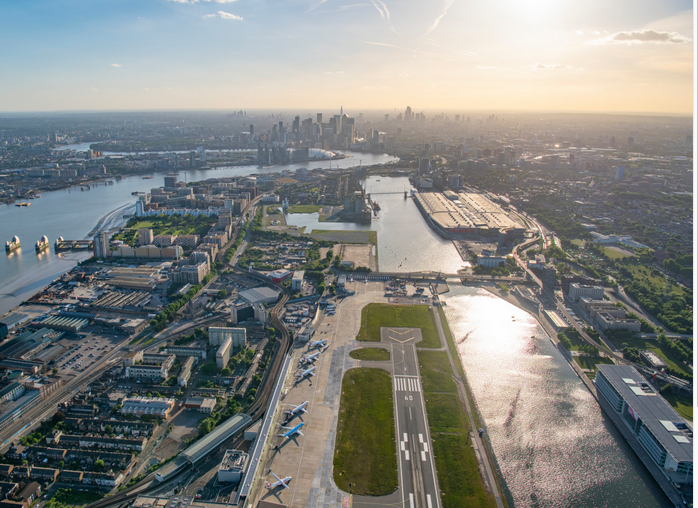
For the record I am against tall buildings for residential. Tall buildings create fire safety hazards, downdraughts, shadow casting, anti-social behaviour in circulation spaces, energy use and maintenance problems connected to lifts. All these issues need to be considered post-Grenfell as the command and control structure of tall residential buildings hasn’t changed, therefore hasn’t improved. If you unlock enough space however, it’s possible to build a lot of mansion blocks four storeys high, or mid-rise blocks up to eight storeys and satisfy London’s demand long term.
At the moment no one is asking the public if London wants to be redefined as a hi-rise city, but there are plenty of voices from across the political spectrum calling for London’s land use to be given a fundamental reset. I know which I prefer.
Recommended reading: